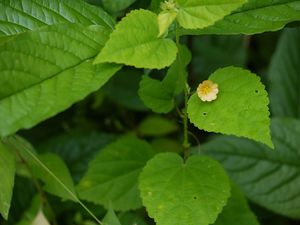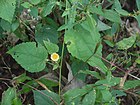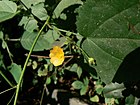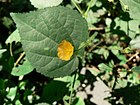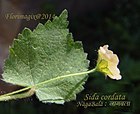Note: This is a project under development. The articles on this wiki are just being initiated and broadly incomplete. You can Help creating new pages.
Sida cordata - Bhumibala
Bhumibala or Sida cordata is a perennial plant producing more or less herbaceous, procumbent stems up to 1 metre long from a woody rootstock.The plant is harvested from the wild for local medicinal use / Ayurvedic medicine and source of fibre.
Contents
[hide]- 1 Uses
- 2 Parts Used
- 3 Chemical Composition
- 4 Common names
- 5 Properties
- 6 Habit
- 7 Identification
- 8 List of Ayurvedic medicine in which the herb is used
- 9 Where to get the saplings
- 10 Mode of Propagation
- 11 How to plant/cultivate
- 12 Commonly seen growing in areas
- 13 Photo Gallery
- 14 References
- 15 External Links
Uses
Pimples, Indigestion, Boils, Wounds, Gonorrhoea, Venereal diseases, Cuts[1]
Parts Used
Chemical Composition
The following alkaloids were reported from S. cordifolia growing in India β-phenethylamine, ephedrine, pseudo-ephedrine, S-(+)-Nb-methyltryptophan methyl ester, hypaphorine, vasicinone, vasicinol, choline, and betaine[2]
Common names
| Language | Common name |
|---|---|
| Kannada | Bekkinathale Gida, Bekkina thale gida |
| Hindi | Bhyunli, Bananiyar, Andiobal |
| Malayalam | Palkurunthotti, Vallikurunthotti, Nela-vaga |
| Tamil | Kurunthotti, Palampaci |
| Telugu | Gayapuvaku, Benda, Tirunala |
| Marathi | NA |
| Gujarathi | NA |
| Punjabi | NA |
| Kashmiri | NA |
| Sanskrit | Bhumibala, Nagabala |
| English | Heart leaf |
Properties
Reference: Dravya - Substance, Rasa - Taste, Guna - Qualities, Veerya - Potency, Vipaka - Post-digesion effect, Karma - Pharmacological activity, Prabhava - Therepeutics.
Dravya
Rasa
Tikta (Bitter), Madhura (Sweet)
Guna
Guru (Heavy), Snigdha (Unctuous)
Veerya
Shita (Cooling)
Vipaka
Madhura (Sweet)
Karma
Prabhava
Habit
Identification
Leaf
| Kind | Shape | Feature |
|---|---|---|
| Cordate | Ovate | Leaves are acute or acuminate, serrate |
Flower
| Type | Size | Color and composition | Stamen | More information |
|---|---|---|---|---|
| Bisexual | Axillary, solitary | Yellow | 5 | Pedicels to 2 cm long, filiform, articulated above the middle. Flowering from October to November |
Fruit
| Type | Size | Mass | Appearance | Seeds | More information |
|---|---|---|---|---|---|
| Schizocarp | 2.5 mm long; mericarps 5, to 3 x 2 mm | Trigonous with rounded angles, apex shortly 2-beaked, completely enclosed in accrescent calyx | Seeds are 2 mm long, reniform, brownish-black | Fruiting season is October to November |
Other features
List of Ayurvedic medicine in which the herb is used
Where to get the saplings
Mode of Propagation
How to plant/cultivate
Seed can be sown in late autumn/spring/summer. Either sow directly into ground or in a pot. Lightly cover with soil and keep moist until they begin to germinate[5]
Commonly seen growing in areas
Grassy roadsides in china, Uncultivated land, Undergrowth in forest.
Photo Gallery
References
- ↑ Jump up to: 1.0 1.1 1.2 "Karnataka Medicinal Plants Volume - 2" by Dr.M. R. Gurudeva, Page No.478, Published by Divyachandra Prakashana, #45, Paapannana Tota, 1st Main road, Basaveshwara Nagara, Bengaluru.
- Jump up ↑ Phytochemistry
- Jump up ↑ Karnataka Medicinal Plants Volume - 2 by Dr.M. R. Gurudeva, Page No. 475
- Jump up ↑ Plant description
- Jump up ↑ Care and Cultivation
External Links
- Ayurvedic Herbs known to be helpful to treat Pimples
- Ayurvedic Herbs known to be helpful to treat Indigestion
- Ayurvedic Herbs known to be helpful to treat Boils
- Ayurvedic Herbs known to be helpful to treat Wounds
- Ayurvedic Herbs known to be helpful to treat Gonorrhoea
- Ayurvedic Herbs known to be helpful to treat Venereal diseases
- Ayurvedic Herbs known to be helpful to treat Cuts
- Herbs with Leaf used in medicine
- Herbs with Root used in medicine
- Herbs with common name in Kannada
- Herbs with common name in Hindi
- Herbs with common name in Malayalam
- Herbs with common name in Tamil
- Herbs with common name in Telugu
- Herbs with common name in Sanskrit
- Herbs with common name in English
- Habit - Perennial herb
- Index of Plants which can be propagated by Seeds
- Herbs that are commonly seen in the region of Grassy roadsides in china
- Herbs that are commonly seen in the region of Uncultivated land
- Herbs that are commonly seen in the region of Undergrowth in forest
- Herbs
- Malvaceae
